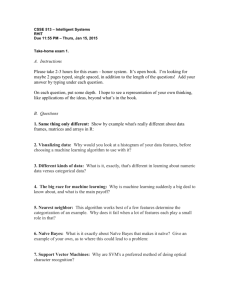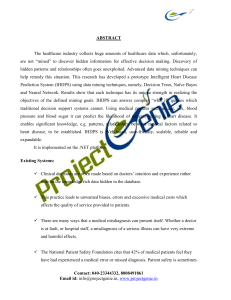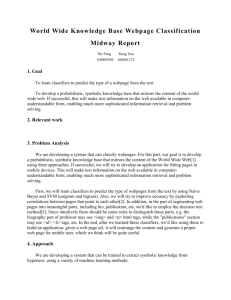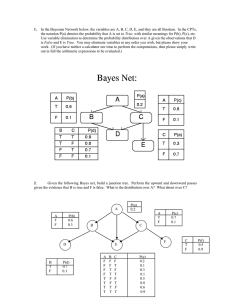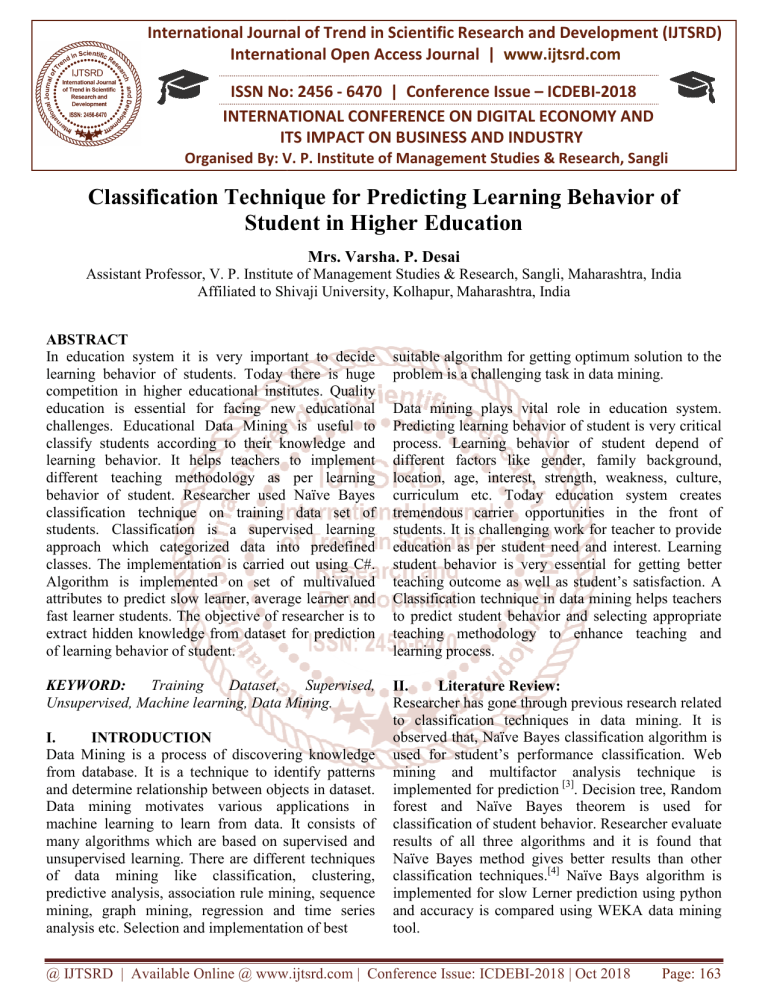
International Journal of Trend in Scientific Research and Development (IJTSRD)
International Open Access Journal | www.ijtsrd.com
ISSN No: 2456 - 6470 | Conference Issue – ICDEBI-2018
ICDEBI
INTERNATIONAL CON
CONFERENCE
FERENCE ON DIGITAL ECONOMY AND
ITS
TS IMPACT ON BUSINESS AND INDUSTRY
Organised By: V. P. Institute of Management Studies & Research, Sangli
Classification Technique for Predicting
g Learning Behavior of
Student in Higher Education
Mrs. Varsha. P. Desai
Assistant Professor, V. P. Institute of Management Studies & Research, Sangli, Maharashtra, India
Affiliated to Shivaji University, Kolhapur
Kolhapur, Maharashtra, India
ABSTRACT
In education system it is very important to decide
learning behavior of students. Today there is huge
competition in higher educational institutes. Quality
education is essential for facing new educational
challenges. Educational Data Mining is useful to
classify
lassify students according to their knowledge and
learning behavior. It helps teachers to implement
different teaching methodology as per learning
behavior of student. Researcher used Naïve Bayes
classification technique on training data set of
students. Classification
lassification is a supervised learning
approach which categorized data into predefined
classes. The implementation is carried out using C#.
Algorithm is implemented on set of multivalued
attributes to predict slow learner, average learner and
fast learner students. The objective of researcher is to
extract hidden knowledge from dataset for prediction
of learning behavior of student.
KEYWORD:
Training
Dataset,
Supervised,
Unsupervised, Machine learning, Data Mining.
I.
INTRODUCTION
Data Mining is a process of discovering knowledge
from database. It is a technique to identify patterns
and determine relationship between objects in dataset.
Data mining motivates various applications in
machine learning to learn from data. It consists of
many algorithms which are based on supervised and
unsupervised learning. There are different techniques
of data mining like classification, clustering,
predictive analysis, association rule mining, sequence
mining, graph mining, regression and time series
analysis etc. Selection andd implementation of best
suitable algorithm for getting optimum solution to the
problem is a challenging task in data mining.
Data mining plays vital role in education system.
Predicting learning behavior of student is very critical
process. Learning behavior
havior of student depend of
different factors like gender, family background,
location, age, interest, strength, weakness, culture,
curriculum etc. Today education system creates
tremendous carrier opportunities in the front of
students. It is challenging work for teacher to provide
education as per student need and interest. Learning
student behavior is very essential for getting better
teaching outcome as well as student’s satisfaction. A
Classification technique in data mining helps teachers
to predict student
tudent behavior and selecting appropriate
teaching methodology to enhance teaching and
learning process.
II.
Literature Review:
Researcher has gone through previous research related
to classification techniques in data mining. It is
observed that, Naïve Bayes classification algorithm is
used for student’s performance classification. Web
mining and multifactor analysis technique is
implemented for prediction [3]. Decision tree, Random
forest and Naïve Bayes theorem is used for
classification of student behavior.
behavior Researcher evaluate
results of all three algorithms and it is found that
Naïve Bayes method gives better results than other
classification techniques.[4] Naïve Bays algorithm is
implemented for slow Lerner prediction using python
and accuracy is compared using WEKA data mining
tool.
@ IJTSRD | Available Online @ www.ijtsrd.com | Conference Issue: ICDEBI-2018 | Oct 2018
Page: 163
International Journal of Trend in Scientific Research and Development (IJTSRD) ISSN: 2456-6470
2456
| IF: 4.101
According to literature review it is found that Naïve
Bayes is suitable classification algorithm for multi
attribute analysis. It is essential to develop user
friendly application which useful in any education
sector. Researcher
cher developed application using C# for
predicting learning behavior of student by
implementing Naïve Bayes theorem.
III.
Classification Techniques:
Classification is a supervised learning method where
data is divided into different categories or classes.
Thee objective of classification to predict target class
for given dataset. There are various techniques of
classification like decision tree, Naïve Bayes
classifier, nearest neighbor approach, artificial neural
network these are important techniques of
classification.
ification. Accuracy of target prediction is
depends upon selection of classification technique. In
many real life situations classification is
fundamentally probabilistic, it is uncertain to which
class record is belong.[1]
IV.
Naïve Bayes Classifier:
Bayesiann classification is based on Bayes theorem.
The posterior probability of the class that a record
belongs to is an approximated using prior probability
which drawn from training dataset. Classification
model estimate the likelihood of the record belonging
to
o each class. The class with highest prevents for Y to
happen when events for X probability becomes the
class label for the record.[2]
Definition of Bayes Theorem: Given two random
variables X and Y, each of them taking a specific
value corresponds to a random event. A conditional
probability P(X/Y) represents the probability of
events for Y to happen when event for X have already
occurred.[2]
P(X/Y) =
P(X/Y).P(Y)
P(X)
P(Y/X) =
P(X/Y).P(Y)
P(Y)
V.
Training Dataset:
Following table shows training dataset of MCA I year
student dataset. Here researcher is interested to predict
learning behavior of student from given training
dataset using Naïve Bayes algorithm. Student data
consists of different attributes like Gender, Area,
SSC_Medium,
SSC_Percentage,
HSC_faculty,
Math_At_HSC,Graduation_Marks,Admission_Type,
Entrance_Rank,ParentsIncome,,Attendance,Communi
Entrance_Rank,ParentsIncome,,Attendan
cation_Skill, Learning_Behavior (Class Label) etc.
Table 1: Training Dataset:
@ IJTSRD | Available Online @ www.ijtsrd.com | Conference Issue: ICDEBI-2018 | Oct 2018
Page: 164
International Journal of Trend in Scientific Research and Development (IJTSRD) ISSN: 2456-6470
2456
| IF: 4.101
VI.
Student related Variables:
VII. Data Pre-processing:
Data was pre-processed by performing following
operations [3]:
1. Converting all fields to categories.
2. Features combine to reduce dimensionality.
3. Missing values are replaced by frequently
occurring values.
VIII. Algorithm:
1. Import dataset into Sqlserver
2. Find probability of each class.
3. Select parameter set as per input requirement.
4. For each input record:
i. For each attribute:
A. Entities are divided into different categories
according to categorical data.
B. Probability is calculated from training dataset.
5. For each attribute in testing dataset
i. For each attribute:
A. Calculate probability and classify the data
accordingly
B. Return the diagnosis parameter and calculated
probability of each class [4].
C. Compare class wise probability value and
Return final classification which has highest
probability.
IX.
Implementation of algorithm:
Here Naïve Bayes algorithm is implemented on above
dataset. C# is used for stepwise implementation of
algorithm and predicting data for unknown
tuple/record.
Algorithm is implemented to predict learning
behavior of student
dent with following known attribute
values:
X= Gender=M, Area=Rural, SSC_Medium=English,
SSC_Percentage=Poor,
HSC_Faculty=Commerce,
HSC_percentage=Good,
Maths_At_HSC=Yes,
Graduation_Marks:Poor,
Admission_Type=MC,
Entrance_Rank=Good,
parents_Income=Low,
parents_Income
Attendance=Average, Communicaton_Skill=Good.
@ IJTSRD | Available Online @ www.ijtsrd.com | Conference Issue: ICDEBI-2018 | Oct 2018
Page: 165
International Journal of Trend in Scientific Research and Development (IJTSRD) ISSN: 2456-6470
2456
| IF: 4.101
In above problem there are three classes:
C1: Learning Behavior Slow
C2: Learning Behavior Fast,
C3: Learning Behavior Average.
Here we need to predict whether X belongs to which
class.
P(X/C1)=0.33*0.33*0.33*0.33*0.66*0.33*1*0.33*0.
0.33*0.33*0.33*0.66*0.33*1*0.33*0.
66*0.66*0.33*0.33*0.66=2.66
P(X/C2)=0.66*0.33*0.66*0.33*0.66*0.33*
0.33*0.33* 0.33*1*0.33*0.33*0.33=1.33
P(X/C3)=0.75*0.75*0.25*0.5*0.25*0.25*0.25*0.5*0.
25*0.25*0.5*0.75*0.25=3.21
P(X/C1)*P(C1)=2.66*0.3=0.798
P(X/C2)*P(C2)=1.33*0.3=0.399
P(X/C3)*P(C3)=3.21*0.4=1.284
P(X/C3)*P(C3) gives highest probability so X
belongs to class C3.
According to Naïve Bayes theorem it is predicted that
given tuple X belongs to class C3. Which means that
there is highest probability that student
ent is Fast Lerner.
X.
Finding:
Implementation of Naïve Bayes theorem using C# we
can find out Fast, Slow and Average learners.
Conclusion:
Naïve bays theorem is implemented using C# to
determine Slow Learner, Average Lerner and Fast
Learner. This application is useful in education
system to categories student according to their
learning behavior. Proposed application is very user
friendly and applicable for any higher education
sector. It helps teachers to implement different
teaching and learning techniques for providing quality
education to the students. Successful implementation
of this model will improve overall result and learning
interest among students.
REFERENCES:
1. Jiawei Han and Micheline Kamber, Data Mining
Concepts and Techniques ISBN-978-81-3120535-8.
2. Hongbo Du,, Data Mining Technique, ISBN-97881-315-1955-4.
3. K. Prasada Rao, M. V. P. Chandra Sekhara Rao,
B. Ramesh, Predicting Learning Behavior of
Students using Classification Techniques,
International Journal of Computer Applications
(0975 – 8887) Volume 139 – No.7, April 2016.
4. Swati and Rajinder Kaur, Using Factor
Classification for the Slow Learner Prediction
overr Various Class of Student Dataset, Indian
Journal of Science and Technology, Vol 9(48),
DOI: 10.17485/ijst/2016/v9i48/103651, December
2016, ISSN (Online): 0974-564.
0974
5. Swati and Rajinder Kaur,, Multifactor Naïve Bayes
Classification For The Slow Learner Prediction
Over Multicass Student Dataset, International
Journal on Computational Science & Applications
(IJCSA) Vol.6, No. 4, August 2016
6. Shiwani Rana*, Roopali Garg, Slow Learner
Prediction using Multi--Variate Naïve Bayes
Classification
Algorithm,
Department
of
Information
Technology,
UIET,
Panjab
University, Chandigarh, India. 02 December
2016.
Scaling up the accuracy of Naïve
7. R. Kohavi, “Scaling
Bayes classifiers: a decision-tree
decision
hybrid," Proc.
International
Conference
on
Knowledge
K
Discovery and Data Mining (KDD 96), ACM,
Aug. 1996, pp. 202-207.
8. C. G. Nespereira, E. Elhariri, N. El-Bendary,
El
A. F.
Vilas, and R. P. D. Redondo, “Machine learning
based classification approach for predicting
student’s performance in blended learning,”
lear
Proc.
International Conference on Advanced Intelligent
System and Informatics (AISI 15), Springer, Nov.
2015, pp. 47-56.
9. Sudha M, Kumaravel A. Performance comparison
based on attribute selection tools for data mining.
Indian Journal of Science and Technology. 2014
Nov; 7(S7):1–5.
10. Weka, University of Waikato, New Zealand,
http://www.cs.waikato.ac.nz/ml/weka/
@ IJTSRD | Available Online @ www.ijtsrd.com | Conference Issue: ICDEBI-2018 | Oct 2018
Page: 166

